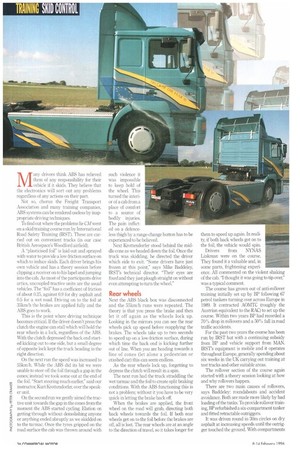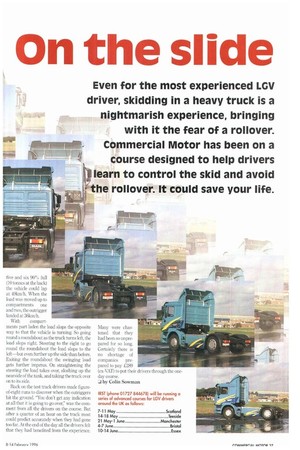TRAINING SKID CONTROL
Page 38

Page 39

If you've noticed an error in this article please click here to report it so we can fix it.
On the slide
Even for the most experienced LGV driver, skidding in a heavy truck is a nightmarish experience, bringing with it the fear of a rollover.
Commercial Motor has been on a course designed to help drivers learn to control the skid and avoid the rollover. It could save your life.
many drivers think ABS has relieved them of any responsibility for their vehicle if it skids. They believe that the electronics will sort out any problems regardless of any actions on their part.
Not so, chorus the Freight Transport Association and many training companies, ABS systems can be rendered useless by inappropriate driving techniques.
To find out where the problems lie CM went on a skid training course run by International Road Safety Training (IRST). These are carried out on convenient tracks (in our case British Aerospace's Woodford airfield).
A "plasticised foil" is laid out and sprayed with water to provide a low-friction surface on which to induce skids. Each driver brings his own vehicle and has a theory session before clipping a receiver on to his lapel and jumping into the cab. As most of the participants drive artics, uncoupled tractive units are the usual vehicles. The "foil" has a coefficient of friction of about 025, against 0.9 for dry asphalt and 0.5 for a wet road. Driving on to the foil at 35kni/h the brakes are applied fully and the ABS goes to work.
This is the point where driving technique becomes critical. If the driver doesn't press the clutch the engine can stall which will hold the rear wheels in a lock, regardless of the ABS. With the clutch depressed the back end started kicking out to one side, but a small degree of opposite lock kept the truck heading in the right direction.
On the next run the speed was increased to 55km/h. While the ABS did its bit we were unable to steer off the foil through a gap in the cones; instead we took seine out at the end of the foil. "Start steering much earlier," said our instructor, Kurt Krottendorfer, over the speaker tmit.
On the second run we gently aimed the tractive unit towards the gap in the cones from the moment the ABS started cycling. Elation on getting through without demolishing anyone or anything ended abruptly as we skidded on to the tarmac. Once the tyres gripped on the road surface the cab was thrown around with such violence it was impossible to keep hold of the wheel. This turned the interior of a cab from a place of comfort to a source of bodily injuries. The pain inflicted on a defenceless thigh by a range-change button has to be experienced to be believed.
Next Krottendorfer stood behind the middle cone as we headed down the foil. Once the truck was skidding, he directed the driver which side to exit. "Some drivers have just frozen at this point," says Mike Baddeley, IRST's technical director. "Their eyes are fixed and they just plough straight on without even attempting to turn the wheel."
Rear wheels




































































































